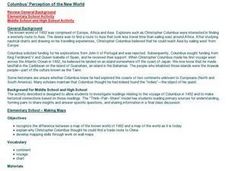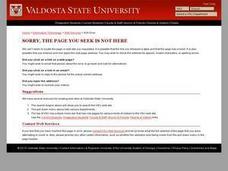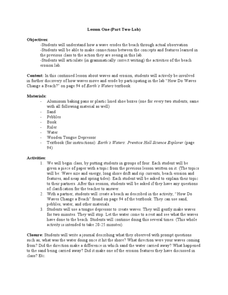Curated OER
I, Robot, Can Do That!
Students describe the three types of underwater robots and the advantages and disadvantages of using them. In this underwater lesson students are given a task and identify the best robot for the job.
Curated OER
First European Settlers:Oh, California
Students trace the paths of the early explorers who sent three expeditions to settle California. They analyze possible reasons why the land expeditions took longer than ocean routes.
Curated OER
Great Explorations: To the End of the Earth and Beyond
Students analyze the factors that affect exploration such as religion, trade, territorial expansion, and science. In this Great Explorations lesson, students determine the names of famous explorers as well as their routes and...
Curated OER
Christopher Columbus
Students read about the good and bad aspects of Christopher Columbus in Jean Fritz's book, "Where do you think you're going, Christopher Columbus?" They conduct and analyze a survey about common myths and create a pop-up book.
Curated OER
Lesson one
Students study waves and how it erodes a beach. In this energy instructional activity students complete a lab activity on waves and tides.
Curated OER
Unsafe Waters
Young scholars investigate deep sea explorations and the challenges that can occur. In this deep-sea exploration lesson students work in groups and create a deep sea exploration mural.
Curated OER
Columbus' Perception of the New World
students investigate readings relating to the voyage of Columbus in 1492 and to make historical connections based on those readings. They form pairs to share insights and answer specific questions, and share information in a final class...
Curated OER
Ponce de Leon
Fifth graders explain that the discoveries of Ponce de Leon were important, both in and of themselves and to the destinies of Europeans and Native Americans. They write an essay highlighting two of his important discoveries.
Curated OER
Voyage to the New World
Third graders investigate the history of North America by creating a map. In this world geography lesson, 3rd graders analyze the voyage Christopher Columbus took to arrive at the new world by creating a map of his...
Curated OER
NOAA Research Project
Young scholars research any topic relating to the National Oceanic and Atmospheric Administration (NOAA) research cruise that Mrs. Richards be participating in.
Curated OER
Lesson Five
Students study ocean habitats and create a habitat zone replica. In this ocean habitat lesson students design and construct their own unique habitat.
Curated OER
Cool Lights
Students investigate how and why deep-sea organisms produce light. They examine how these processes can be used to study deep ocean environments.
Curated OER
Nutrition and Health
Students explore the conditions faced while sailing on the ocean regarding health and physical fitness. They experience the importance of Vitamin C. Students analyze the cause of many diseases and sicknesses on the ships.
Curated OER
How Do Waves Change a Beach?
Students conduct an experiment on beach erosion. In this earth science lesson plan, students create a beach model and use tongue depressor to produce waves. They write a journal about their observations.
NOAA
Methane Hydrates – What's the Big Deal?
Have you ever tried to light ice on fire? With methane hydrate, you can do exactly that. The ice forms with methane inside so it looks like ice, but is able to burn. The lesson plan uses group research and a hands-on activity to help...
Monterey Bay Aquarium
What's in a Name?
Combine art and word analysis in a lesson about genus and species. Elementary children sleuth out the meaning of scientific names for a number of shark species using a prefix and suffix definition chart. They then draw an image of the...
Ocean Explorer
Architects of the Coral Reef
Coral Reefs are the focus of a life science lesson plan. Upper graders look at how coral reefs are formed, how the animals and plants reproduce, and the variety of ways that humans benefit from coral reefs around the world. Groups of...
Curated OER
How Diverse is That?
Compare various types of biological diversity in a coral reef and calculate a numeric indicator that describes the diversity found in coral communities. Your class can work in groups to look at the abundance and distribution data of...
Curated OER
Save a Reef!
Design a public information campaign to improve understanding of the coral reef crisis. Read about and discuss the biology and threats to the coral reef. The class creates a public information program about the problems facing the coral...
Curated OER
It's Going to Blow Up!
Students discover the major characteristics of volcanoes on the Pacific Ring of Fire. They describe the processes that produce the "Submarine Ring of Fire." students explain the factors that contribute to explosive volcanic eruptions.
Curated OER
I, Robot, Can Do That!
Students describe underwater robots. In this robot lesson, students describe and contrast three types of underwater robots used for scientific exploration. This lesson includes several activities, a handout, background data, and multiple...
Curated OER
Ancient Bugs
Students describe Archaea. In this biology lesson plan, students examine biological communities and the role Archaea plays. Students will compare and contrast the Archaea with bacteria and eukaryote.
Curated OER
Architects of the Coral Reef
Students discuss reproduction in Cnidaria. in this coral reef lesson, students describe five characteristics of Cnidaria and compare and contrast the four classes. They describe the reproduction strategies they use.
Curated OER
How do living and non-living structures affect coral reef habitats?
Students create model coral reefs showing surface area and including examples of communities. In this coral reef lesson, students research and explore the functions or benefits from a coral reef. Students design a benthic...























